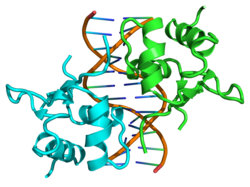Biology:Heat shock factor
| HSF-type DNA-binding | |||||||||||
|---|---|---|---|---|---|---|---|---|---|---|---|
 | |||||||||||
| Identifiers | |||||||||||
| Symbol | HSF_DNA-bind | ||||||||||
| Pfam | PF00447 | ||||||||||
| InterPro | IPR000232 | ||||||||||
| PROSITE | PDOC00381 | ||||||||||
| SCOP2 | 1hks / SCOPe / SUPFAM | ||||||||||
| |||||||||||
| Vertebrate heat shock transcription factor | |||||||||
|---|---|---|---|---|---|---|---|---|---|
| Identifiers | |||||||||
| Symbol | Vert_HS_TF | ||||||||
| Pfam | PF06546 | ||||||||
| InterPro | IPR010542 | ||||||||
| |||||||||
In molecular biology, heat shock factors (HSF), are the transcription factors that regulate the expression of the heat shock proteins.[1][2] A typical example is the heat shock factor of Drosophila melanogaster.[3]
Function
Heat shock factors (HSF) are transcriptional activators of heat shock genes.[3] These activators bind specifically to Heat Shock sequence Elements (HSE) throughout the genome[4] whose consensus-sequence is a tandem array of three oppositely oriented "AGAAN" motifs or a degenerate version thereof. Under non-stressed conditions, Drosophila HSF is a nuclear-localized unbound monomer, whereas heat shock activation results in trimerization and binding to the HSE.[5] The Heat Shock sequence Element is highly conserved from yeast to humans.[6]
Heat shock factor 1 (HSF-1) is the major regulator of heat shock protein transcription in eukaryotes. In the absence of cellular stress, HSF-1 is inhibited by association with heat shock proteins and is therefore not active. Cellular stresses, such as increased temperature, can cause proteins in the cell to misfold. Heat shock proteins bind to the misfolded proteins and dissociate from HSF-1. This allows HSF1 to form trimers and translocate to the cell nucleus and activate transcription.[7] Its function is not only critical to overcome the proteotoxic effects of thermal stress, but also needed for proper animal development and the overall survival of cancer cells.[8][9]
Structure
Each HSF monomer contains one C-terminal and three N-terminal leucine zipper repeats.[10] Point mutations in these regions result in disruption of cellular localisation, rendering the protein constitutively nuclear in humans.[5] Two sequences flanking the N-terminal zippers fit the consensus of a bi-partite nuclear localization signal (NLS). Interaction between the N- and C-terminal zippers may result in a structure that masks the NLS sequences: following activation of HSF, these may then be unmasked, resulting in relocalisation of the protein to the nucleus.[10] The DNA-binding component of HSF lies to the N-terminus of the first NLS region, and is referred to as the HSF domain.
Isoforms
Humans express the following heat shock factors:
| gene | protein |
|---|---|
| HSF1 | heat shock transcription factor 1 |
| HSF2 | heat shock transcription factor 2 |
| HSF2BP | heat shock transcription factor 2 binding protein |
| HSF4 | heat shock transcription factor 4 |
| HSF5 | heat shock transcription factor family member 5 |
| HSFX1 | heat shock transcription factor family, X linked 1 |
| HSFX2 | heat shock transcription factor family, X linked 2 |
| HSFY1 | heat shock transcription factor, Y-linked 1 |
| HSFY2 | heat shock transcription factor, Y-linked 2 |
See also
References
- ↑ Sorger PK (May 1991). "Heat shock factor and the heat shock response". Cell 65 (3): 363–6. doi:10.1016/0092-8674(91)90452-5. PMID 2018972.
- ↑ Morimoto RI (March 1993). "Cells in stress: transcriptional activation of heat shock genes". Science 259 (5100): 1409–10. doi:10.1126/science.8451637. PMID 8451637. Bibcode: 1993Sci...259.1409M.
- ↑ 3.0 3.1 "Molecular cloning and expression of a hexameric Drosophila heat shock factor subject to negative regulation". Cell 63 (5): 1085–97. November 1990. doi:10.1016/0092-8674(90)90511-C. PMID 2257625.
- ↑ "Chromatin landscape dictates HSF binding to target DNA elements". PLOS Genet. 6 (9): e1001114. September 2010. doi:10.1371/journal.pgen.1001114. PMID 20844575.
- ↑ 5.0 5.1 "Molecular cloning and expression of a human heat shock factor, HSF1". Proc. Natl. Acad. Sci. U.S.A. 88 (16): 6906–10. August 1991. doi:10.1073/pnas.88.16.6906. PMID 1871105. Bibcode: 1991PNAS...88.6906R.
- ↑ "Drosophila heat shock system as a general model to investigate transcriptional regulation". Cold Spring Harb. Symp. Quant. Biol. 75: 1–9. 2010. doi:10.1101/sqb.2010.75.039. PMID 21467139.
- ↑ "Integrating the stress response: lessons for neurodegenerative diseases from C. elegans". Trends Cell Biol. 19 (2): 52–61. February 2009. doi:10.1016/j.tcb.2008.11.002. PMID 19112021.
- ↑ "An RNA aptamer perturbs heat shock transcription factor activity in Drosophila melanogaster". Nucleic Acids Res. 39 (15): 6729–40. August 2011. doi:10.1093/nar/gkr206. PMID 21576228.
- ↑ "Inhibiting heat shock factor 1 in human cancer cells with a potent RNA aptamer". PLOS ONE 9 (5): e96330. 2014. doi:10.1371/journal.pone.0096330. PMID 24800749. Bibcode: 2014PLoSO...996330S.
- ↑ 10.0 10.1 "Isolation of a cDNA for HSF2: evidence for two heat shock factor genes in humans". Proc. Natl. Acad. Sci. U.S.A. 88 (16): 6911–5. August 1991. doi:10.1073/pnas.88.16.6911. PMID 1871106. Bibcode: 1991PNAS...88.6911S.
 |
